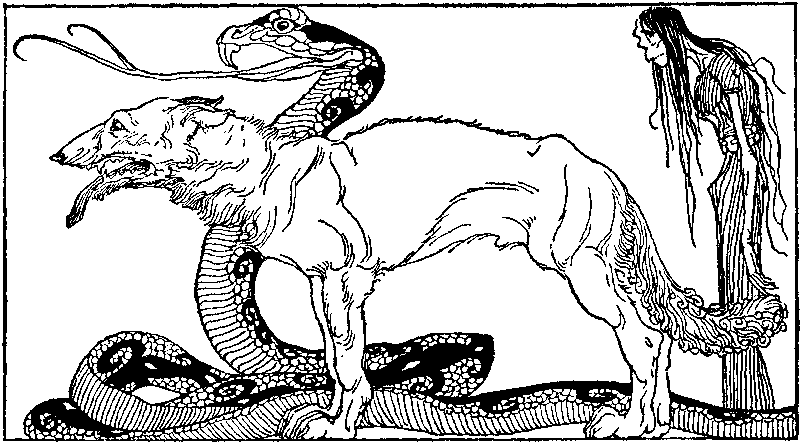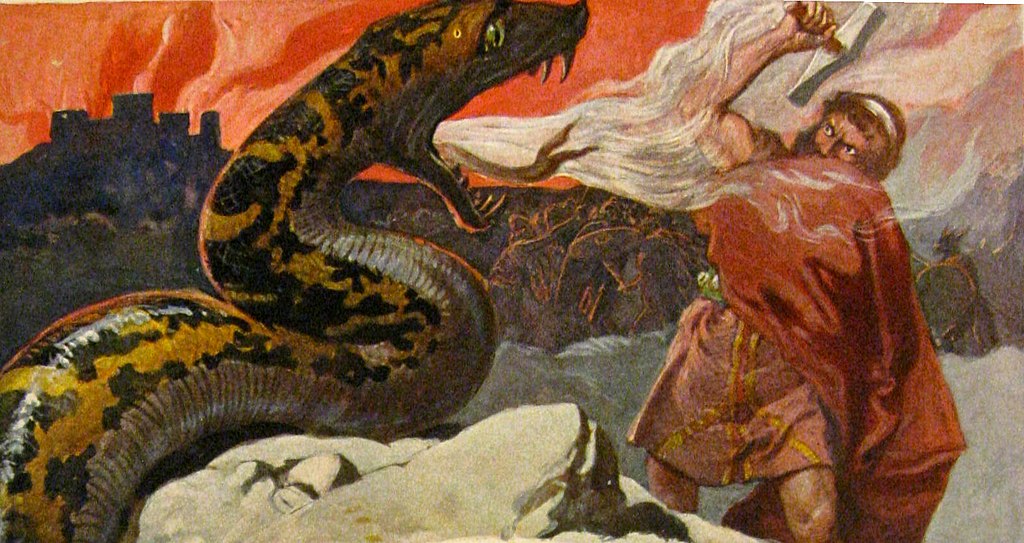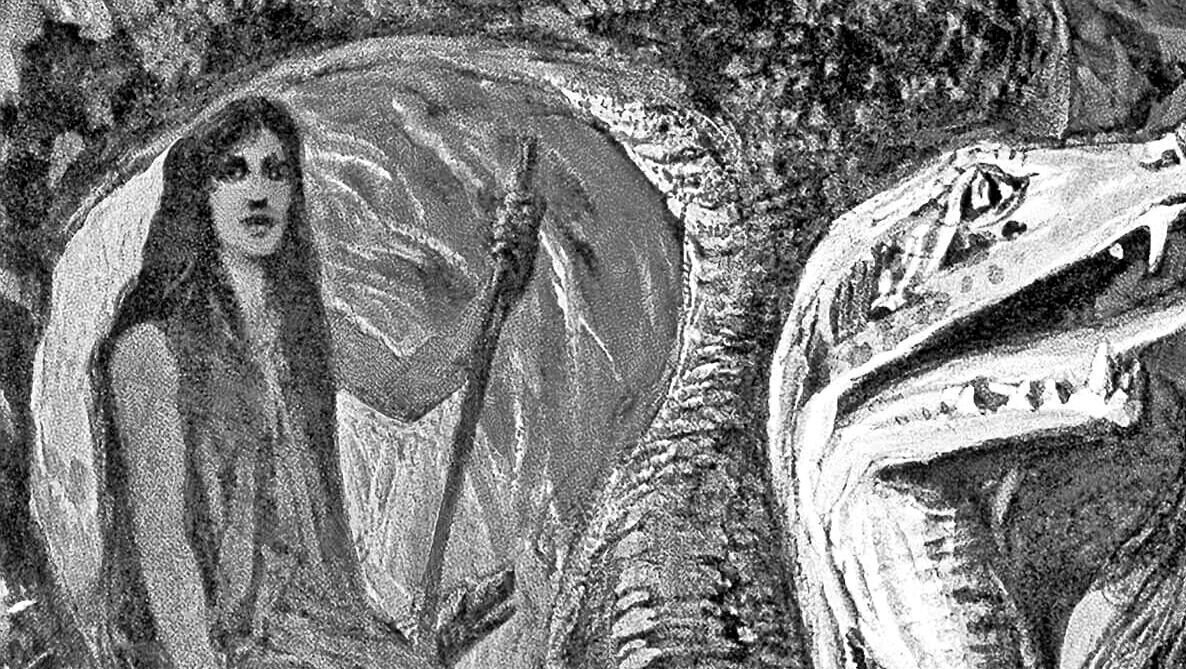According to the Norse myth, The mischief god Loki’s mate, Angrboda, was a jötunn (a giant from Jotunheim) and the mother of a monstrous brood consisting of Hel, Fenrir, and Jörmungandr.
The origin story of Angrboda does not appear in any of the Old Norse texts. All we know is from which realm she hails and that she gave birth to three offspring that would play a major role in Ragnarök, the Norse end of the world.
Who is Angrboda?
Not much is known about Angrboda. According to the Prose Edda and the Poetic Edda, she is a jötunn from the giant’s realm of Jotunheim.
She is Loki’s mate and bears him three children: a massive wolf called Fenrir; Hel, the ruler of the realm of the dead; and Jörmungandr, the Midgard serpent.
Angrboda is not to be confused with Sigyn, who was Loki’s wife.
What Does Angrboda’s Name Mean?
Angrboda’s (Old Norse: Angrboða) name means “The one who brings grief.”
The English word “anger” comes from the first syllable, although the Old Norse meaning is “regret” or “sorrow,” and the former is still true in modern Scandinavian languages. Icelandic uses a slightly different form: “angur.”
“Boða,” the second part of the word, is a cognate of the English word “bode.”
Loki And Angrboda’s Offspring
All three of Angrboda and Loki’s children are banished or imprisoned when born as they are so dangerous.

Fenrir
Fenrir is a huge wolf whose birth throws the Æsir (the Asgard gods) into a panic, afraid of what such a colossal beast might be capable of.
Chapter 34 of The Gylfaginning tells how Odin subsequently orders Skírnir, his wife’s servant, Freyja, to go to Svartalfheim. There he has to ask the dwarf metalsmiths to make a leash strong enough to hold the wolf. The dwarves use six magical elements to make a chain and collar called “Gleipnir”:
- Bear sinews
- A fish’s breath
- Bird spit
- A woman’s beard
- The roots of a mountain
- The sound of a cat’s tread
Hár (one of Odin’s many aliases) says the collar and chain are as soft as silk but strong enough to restrain the monstrous wolf.
The giant wolf is prophecized to consume everything in his path during Ragnarök, his upper jaw touching the heavens and his lower jaw the earth. Fenrir eats Odin whole before one of his sons, Vidar, wearing a magic shoe that helps him to hold the wolf’s mouth open, kills it by driving his sword through its throat.
Fenrir is also called Hróðrsvitnir in the poem Lokasenna, which could mean he is the father of the wolves Skoll and Hati, who also appear during Ragnarök.

Hel
Hel, or the “Goddess of Death,” was sent by Odin to rule the underworld realm of the dead, known as Helheim.
She is the only daughter of the trickster god Loki and Angrboda. Although reports often refer to Hel as a goddess, she is really a demi-god (being the daughter of one) and half jötunn.
Viking descriptions of Hel depict her as being half-black or half-blue and half-white. She has a gloomy and threatening disposition.
Hel has a handmaiden and manservant called Ganglöt and Ganglati. She will recruit an army of the dead during Ragnarök and command the Naglfar, a ship made of human fingernails and toenails, and sail to Vigrid to participate in the battle.
Jörmungandr
Jörmungandr, or the Midgard Serpent, was sent to the sea around Midgard and grew to encircle the entire world. The serpent is described as the longest being in the nine worlds of Norse mythology.
During Ragnarök, Jörmungandr will rise from the water and spray venom across the land and sea. Thor kills Jörmungandr with his hammer Mjölnir, but the poisonous serpent has bitten him, and he too dies after taking nine steps.

Angrboda Attestations
The Gylfaginning
The Gylfaginning from the Prose Edda by the Icelandic poet Snorri Sturluson mentions that her mother’s nature was evil and she would create mischief and disaster. It also tells us she is a “giantess in Jötunheim” that is the mother of three terrible beasts: Fenrir, the giant wolf; Hel, the ruler of the realm of the dead; and Jörmungandr, the Midgard serpent.
Yet more children had Loki. Angrboda was the name of a certain giantess in Jötunheim, with whom Loki gat three children: one was Fenris-Wolf, the second Jörmungandr that is the Midgard Serpent, and the third was Hel.
But when the gods learned that this kindred was nourished in Jötunheim, and when the gods perceived by a prophecy that from this kindred great misfortune should befall them; and since it seemed to all that there was the great prospect of ill (first from the mother’s blood, and yet worse from the father’s).
Angrboda – Germanic Mythology
Völuspá Hin Skamma
The Poetic Edda mentions her on only one occasion – in the Völuspá Hin Skamma – when Loki describes her as the mother of Fenrir.
Loki sired the wolf on Angrboda,
Handbook of Norse Mythology – John Lindow – Page 59
and got Sleipnir on Svadilfari;
the witch alone seemed most evil,
the one that came from the brother of Byleipt.
The Völuspá
Stanza 40 of The Völuspá (or the Völva’s Prophecy) tells of a jötunn, probably Angrboda, living in the forest of Járnvid (or Ironwood), where many female jötnar live.
To the east sat the old lady in Járnvid
Norse Mythology: A Guide to Gods, Heroes, Rituals, and Beliefs – John Lindow
And raised there the kinfolk of Fenrir.
This stanza is also referenced in The Gylfaginning.
Hyndluljóð
In the Old Norse poem Hyndluljóð (Old Norse: ‘The Lay of Hyndla’), a giantess rides a wolf to Valhalla accompanied by Freyja, who rides her wild boar.
How Does Angrboda Die?
There is no information in any Norse mythology texts about how Angrboda died.
Angrboda: Norse Mythology Vs. Marvel
Many aspects of “Angerboda” in the Marvel Universe correspond to her depictions in Norse mythology. The MU describes her as a giantess from Jotunheim, mate of Loki and mother of “Hela,” the Midgard Serpent and the Fenris wolf.
However, many events do not appear in Viking legends, such as her father being the Elderspawn Vârcolac and her mother, Echidna. The MU also believes that each of Angerboda’s offspring took the form their shapeshifting parents had during their conception.
In the MU, a story about Thor recalling a dead Angerboda from the realm of the dead and taking revenge on Loki does not appear in Norse mythology either.
Her defeat by the Young Avengers is also an MU creation.
Other Modern References
Angrboda appears in the 2022 video game God of War Ragnarok.

